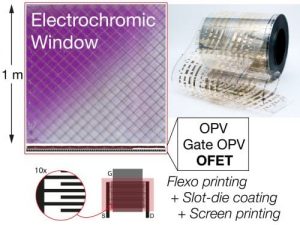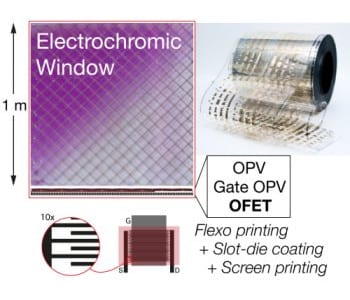 Electrochromic surfaces have the property that they can change colour and transparency according to the application of an electrical current. This can be explored as displays, signage or simple shading elements. The advantage is that it works over large surfaces (many square metres) with little electrical energy input.
Electrochromic surfaces have the property that they can change colour and transparency according to the application of an electrical current. This can be explored as displays, signage or simple shading elements. The advantage is that it works over large surfaces (many square metres) with little electrical energy input.
The challenge has always been that they need to be powered by an external source and in new research F. Krebs et al. study how the same roll-to-roll printing methodologies can be explored for printing of electrochromics, transistor logic and solar cell power units.
The advantage of the integrative approach the researchers developed is that the electrochromic device, the logic that powers it and the powering unit is all prepared in the same process steps resulting in a stand-alone electrochromic for i.e. shading applications. The important question is answered of how large a proportion of the available area that is required to harvest solar energy and driver logic and how much that is left for the electrochromic.
The findings confirm that very little of the total area is needed for the solar cells and transistors pending the development of an organic power transistor that is also described the roll-to-roll manufacture and operation of. The future of organic electrochromics is thus promising and the synergy in terms of roll-to-roll processing and materials between transistors, solar cells and electrochromics are in this work explored to the fullest. The devices do not employ indium-tin-oxide with electrodes being printed silver grids for the electrochromics and printed silver comb structures for the solar cells and the transistors.
The thin outline of the devices explored in the present work (< 100 micron in packaged form) implies that thin foil can be manufactured using full roll-to-roll processing; thin foil that has everything integrated without the need for making external connections. The vision of organic electronics as being a fully integrated functional thin foil that can be attached to any surface and operated autonomously is thus a laboratory reality and very close to scaled manufacture and use.

















